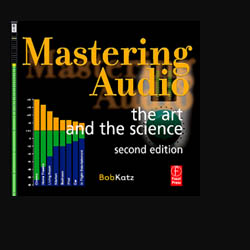This article is the first part in a series on decibels, excerpted from Bob Katz’s book Mastering Audio: The Art and The Science.
So many of us take our meters for granted—after all, recording is simple: all you do is peak to 0 dB and never go over!
But things only appear that simple until you discover that with the same material, one machine says that it peaks to -1 dB, another machine shows an OVER level, and yet your workstation tells you it just reaches 0 dB!
To make things worse, among the expensive digital meters available, only a handful accurately convey the
information we really need to know.
In this chapter we will explore the different types of meters, the concept of the digital OVER, analog and digital headroom, gain staging, loudness, signal-to-noise ratio and we will also take a fresh look at the common practices of dubbing and level calibration.
Bob’s Top 10 List of Slippery & Confusing Audio Terms
10. INTENSITY… is a measure of energy flow per unit area. For practical purposes, sound intensity is the same as SPL (see below).
9. LEVEL…is a measure of intensity, but when used alone, because it can mean almost anything, it means absolutely nothing! To avoid confusion, the level figure should always be qualified by a ‘unit’ term, e.g. voltage level, sound pressure level, digital level.
Examples: 40 dB SPL, -20 dBu, -25 dBFS. Each suffix defines the reference. SPL (sound pressure level) is a measure of the amplitude or energy of the physical sound present in the atmosphere. 40 dB SPL and 0.002 Pa (Pascals) are the same pressure, the first expressed in decibels relative to 0 dB SPL, the second in absolute pressure units.
8. DECIBEL (dB)… is a relative quantity; it is always expressed as a ratio, compared to a reference. For example, what if every length had to be compared to one centimeter? You’d say, “this piece of string is ten times longer than one centimeter.”
It’s the same thing with decibels, though sometimes the reference is not explicitly stated but just implied. +10 dB means “10 dB more than my reference, which I defined as 0 dB.” Decibels are logarithmic ratios, so if we mean “twice as much voltage,” we say “6 dB more” [20 * log (2) = 6]. DBU, DBM, DB SPL, DBFS… are ratios with predefined references, so they can be converted to absolute values in volts, power, etc.
I believe the term dBu was coined in the 1960’s by the Neve Corporation; it means decibels unterminated, compared to a voltage reference of 0.775 volts.
dBm means decibels compared to a power reference of one milliwatt.
dBFS means decibels compared to full scale PCM; 0 dBFS represents the highest digital level we can encode.
Plurals. We do say “two decibels”, but we do not pluralize the abbreviation. We do say “two dee bee”, but we do not say “two dee bees”.
7. GAIN or AMPLIFICATION… is a relative term expressed in plain decibels with no suffix: it is the ratio of the amplifier’s output level to the input level. If an amplifier receives an input of -23 dBu and puts out an output of +4 dBu, it has 27 dB gain (without any suffix). See Sidebar.
















